What inspired African Americans to leave their homes during the Great Migration?
Historians often explain migration as some combination of "push-pull" factors. Oppressive conditions at home like poverty, government persecution, military conscription, high taxes, systemic racism or lack of opportunity might be sufficient to persuade people to seek better conditions elsewhere. Likewise, economic opportunity, religious and political freedom, family ties or a desire for adventure could induce some to pack their bags for a new location.
End of Reconstruction
African Americans in the 50 years after the Civil War responded to both push and pull factors. At the end of Reconstruction and federal oversight of southern states, white majorities resumed control of the government and enacted laws severely discriminating against African Americans. They were denied the right to vote or to serve on juries. Extra-legal, racially-motivated organizations like the Ku Klux Klan terrorized African Americans with threats and incidents of lynchings and other forms of violence. Schools and public accommodations were strictly segregated, and any African American who protested or failed to obey the restrictions ran the risk of retribution, legal or otherwise. The U.S. Supreme Court in Plessy v. Ferguson upheld the principle of "separate but equal" facilities, but the African-American institutions were never "equal." African-American schools were in poor facilities with inadequate textbooks with poorly paid and prepared teachers.
The Great Migration
At the turn of the 20th Century, southern African Americans began moving North in larger numbers seeking a better living (pull) and leaving southern segregation (push). The rapid growth of northern cities like Chicago, Philadelphia, New York and Boston opened up new job possibilities and better schools. While they were often segregated, legally or informally, into African-American neighborhoods and denied the opportunity to live elsewhere, those neighborhoods often developed vibrant Black culture. The Harlem Renaissance produced outstanding music, art and literature in the 1920s.
On the other hand, African Americans faced push back from recently arrived immigrant groups who were also seeking jobs. The rapid growth of the cities put a premium on housing, and in this also, African Americans found themselves competing with other ethnic minorities. While African-American professionals might develop successful practices within the Black community, they rarely found their services welcomed in the larger society. As they had done in the South, African-American women found work as domestics, cooks and laundry workers. If white middle-class women rarely worked outside the home, economic necessity forced African-American women, married or not, to seek outside employment.
Labor shortages in World War I created new opportunities for African-American workers, and the Great Migration picked up speed. African-American struggles did not end when they arrived in the North, but they did escape the entrenched segregation of the post-Civil War South.
Supporting Questions
Why did African Americans migrate?
- "Lynching Black People Because They Are Black" by Frederick Douglass, April 1894 (Document)
- "What a Colored Man Should Do To Vote" Pamphlet from Virginia, 1900 (Document)
- Illustration from "The Exodus," 1919 (Image)
- "Great Migration Railroad Strike 100 Years Ago Brought an Influx of African-Americans to Waterloo" Newspaper Article, February 1, 2011 (Document)
What issues did African Americans face in the South in the beginning of the 20th century?
- "Why Disfranchisement is Bad," 1904 (Document)
- Guinn v. United States, 1914 (Document)
- "A New Reconstruction" Letter, May 1919 (Document)
- "Antilynching Bill" Report, 1921 (Document)
- "Lynchings by States and Counties in the United States, 1900-1931" Map, ca. 1931 (Map)
What benefits did African Americans find in northern cities?
- "Ho for Kansas" Advertising Flyer, March 18, 1878 (Image)
- "National Negro Committee" Platform, 1909 (Document)
- Perfect Eat Shop in Chicago, Illinois, April 1942 (Image)
- Two Women Working in a Factory Making Bedspring Webbing, 1969 (Image)
- Madame C. J. Walker and Her Mansion on the Hudson in New York, ca. 1987 (Image)
What difficulties did African Americans find in northern cities?
- "Chicago Race Riots Spread" Newspaper Article, July 30, 1919 (Document)
- African-American Man Carrying Protest Sign Outside Milk Company in Chicago, Illinois, July 1941 (Image)
- Picket Line at Mid-City Realty Company in Chicago, Illinois, July 1941 (Image)
- "White Tenants in Our White Community" Sign Directed at U.S. Federal Housing Project in Detroit, Michigan, February 1942 (Image)
| Great Migration Teaching Guide |
| Printable Image and Document Guide |
"Lynching Black People Because They Are Black" by Frederick Douglass, April 1894
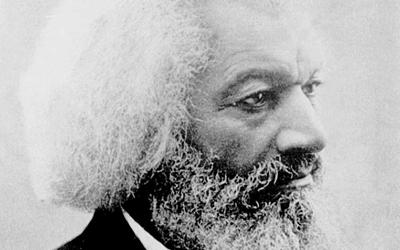
Download Resource Download Resource
Description
This is an article written by Frederick Douglass and published in The Christian Educator in 1894. It focuses on the horrible treatment and violent abuse of African Americans in southern states after the end of legal enslavement in the United States and the…
"What a Colored Man Should Do To Vote" Pamphlet from Virginia, 1900
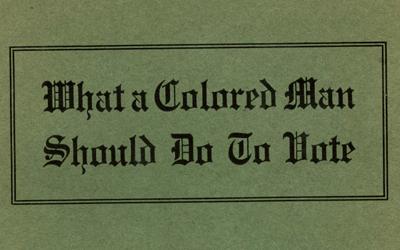
Download Resource Download Resource
Description
"What a Colored Man Should Do To Vote" was a pamphlet from 1900 that explained what discriminatory restrictions were being implemented against African Americans when they attempted to vote in the states listed. Most of the states in the pamphlet are in the South and had…
Illustration from "The Exodus," 1919
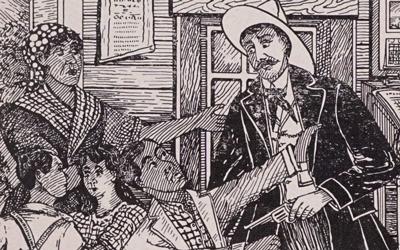
Description
This is an illustration in the book The Exodus, which was written by Clyde Randall and Ed Winn in 1919. The illustration depicts an African-American man who is in debt to a white southern man who is holding him at gunpoint. The image speaks to the ongoing…
“Great Migration Railroad Strike 100 Years Ago Brought an Influx of African-Americans to Waterloo" Newspaper Article, February 1, 2011
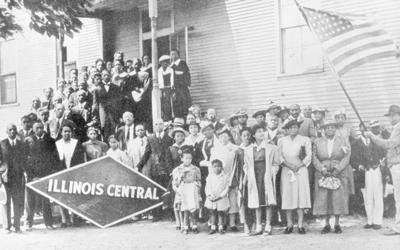
Description
This Waterloo-Cedar Falls Courier newspaper article was written by Pat Kinney in 2011 about African Americans who migrated to Waterloo, Iowa, as strikebreakers in the 1911 Railroad Strike. Many had originally been excluded from this line of work by racial…
"Why Disfranchisement is Bad," 1904

Download Resource Download Resource
Description
This pamphlet for African Americans was published in 1904, and its author, Archibald Henry Grimke, discusses the disfranchisement of African Americans in the South. He describes that, ultimately, the suppression of African Americans was bad for everyone involved.
Guinn v. United States, 1914
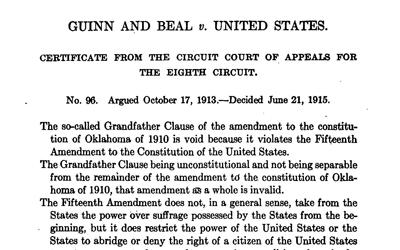
Download Resource Download Resource
Description
The 1914 U.S. Supreme Court ruling, given by Chief Justice Edward White, which outlawed the "Grandfather Clause" and any "literacy test" enacted in the Oklahoma State Constitution and its amendments, and affirmed the conviction of election officials who denied African…
"A New Reconstruction" Letter, May 1919
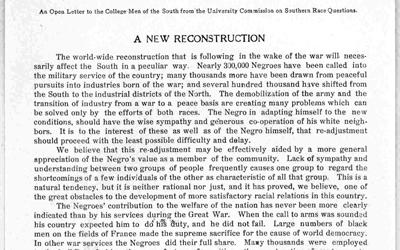
Description
This was a letter drafted by college professors of the University Commission on Southern Race Questions and it was directed to college-age men. The letter discusses a "new reconstruction," how African Americans are able to contribute to the "Great War" and that…
"Antilynching Bill" Report, 1921

Download Resource Download Resource
Description
This was a report submitted by the Committee on the Judiciary to accompany House Bill 13, "The Antilynching Bill," which details research and support for passing the bill into law that would make illegal the practice of lynching.
"Lynchings by States and Counties in the United States, 1900-1931" Map, ca. 1931
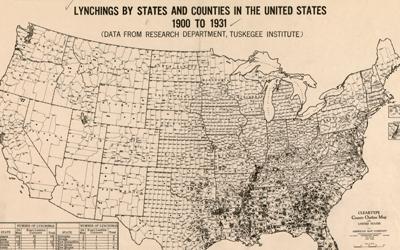
Description
This was a map depicting the number of lynchings by state and county in the United States from 1900 to 1931. The map shows the heaviest concentration of lynchings occurring in southern states.
"Ho for Kansas" Advertising Flyer, March 18, 1878

Description
This is a flyer advertising land available in Kansas for African Americans leaving the south and traveling to the southwest as a part of the Real Estate and Homestead Association in Nashville, Tennessee, in 1878.
"National Negro Committee" Platform, 1909
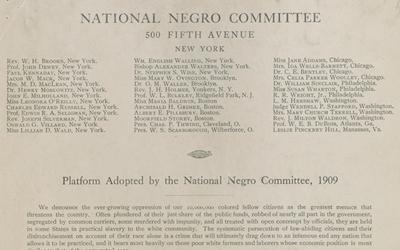
Description
William English Walling’s exposé about a bloody race riot in Springfield, Illinois, Abraham Lincoln’s hometown and burial site, resulted in the assembly of an interracial group to discuss proposals for an organization that would advocate the civil and political rights of…
Perfect Eat Shop in Chicago, Illinois, April 1942
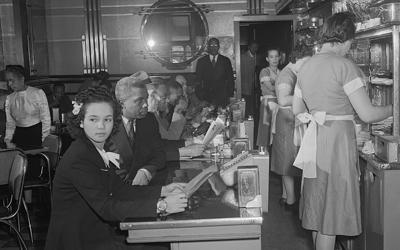
Description
The photograph shows African Americans eating at a local, Black-owned Chicago restaurant in 1942. Most diners and employees are African American, and several small businesses in this area of Chicago were owned and operated by African Americans who had migrated north during…
Two Women Working in a Factory Making Bedspring Webbing, 1969

Description
During World War I, industrial opportunities became available to women when workers were needed to replace men drafted into military service. Black women responded to the demand by leaving their homes and domestic jobs. These two African-American women are seen working in a…
Madame C. J. Walker and Her Mansion on the Hudson in New York, ca. 1987
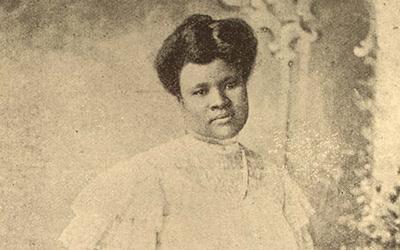
Download Resource Download Resource
Description
This mansion drafted in 1918 was designed by an African American architect, Vertner Woodson Tandy, for African-American cosmetics magnate Madame C. J. Walker. Madame Walker was the first African-American woman to become a self-made millionaire. Madam Walker invented a line…
"Chicago Race Riots Spread" Newspaper Article, July 30, 1919
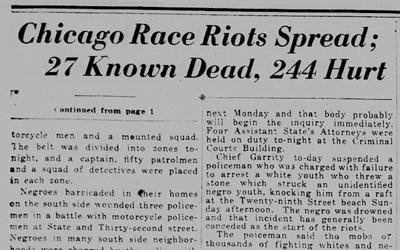
Download Resource Download Resource
Description
This New York Tribune article written in July of 1919 during the "Chicago Race Riots." On July 27, 1919, an African-American teenager drowned in Lake Michigan after violating the unofficial segregation of Chicago’s beaches and being stoned by a group of white…
African-American Man Carrying Protest Sign Outside Milk Company in Chicago, Illinois, July 1941

Description
This photograph shows an African-American man standing in a picket line for the Negro Labor Relation League with a sign protesting Bowman Dairy in Chicago, Illinois.
Picket Line at Mid-City Realty Company in Chicago, Illinois, July 1941
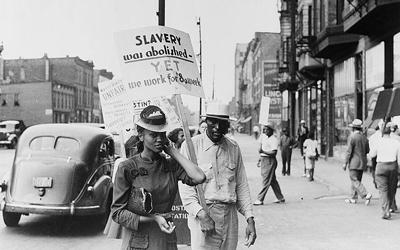
Description
This photograph shows African Americans standing in a picket line outside a midtown business in Chicago, Illinois, in 1941 protesting the discriminatory wage gap between African Americans and white people in the workforce.
"White Tenants in Our White Community" Sign Directed at U.S. Federal Housing Project in Detroit, Michigan, February 1942
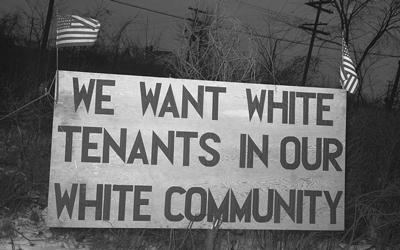
Description
This is a photograph of a protest sign placed outside a housing project for African Americans in Detroit, Michigan. Detroit was one of many northern cities African Americans migrated to from the South during the Great Migration.
Additional Resources
- The African-American Mosaic: Migrations
This webpage features primary sources in the Library of Congress that highlight African-American journeys during the Great Migration. - Population Map
This map, from the Library of Congress, shows the "Distribution of Negro population by county" in 1950. - "The Lynching of Negroes in the South"
This booklet from Rev. Francis James Grimke focuses on the brutal action of lynching against African Americans in the South. - Guinn v. United States
This webpage is an overview of the U.S. Supreme Court case, Guinn v. United States, as presented by the Oklahoma Historical Society. - John Baskerville Interview
This Waterloo-Cedar Falls Courier interview, by Pat Kinney, focuses on the story of John Baskerville, who explains how African Americans migrated to the Waterloo area. - Chicago Examiner at the Chicago Public Library
The Chicago Examiner was one of a dozen major newspapers published in Chicago at the turn of the last century. It was known for its sensational news stories. - The Black Metropolis Resource Consortium (BMRC)
The BMRC is a Chicago-based membership organization of libraries, universities and other archival institutions. Its mission is to make broadly accessible its members' holdings of materials that document African American and African diasporic culture, history and politics, with a specific focus on materials relation to Chicago. - DuSable to Obama: Chicago's Black Metropolis
From the 1920s through the 1950s, Chicago's South Side was the center for African-American culture and business. Known as "Bronzeville," the neighborhood was surprisingly small, but at its peak more than 300,000 lived in the narrow, seven-mile strip. - "The Negro in Chicago: A Study of Race Relations and a Race Riot"
This 1922 report, "The Negro in Chicago: A Study of Race Relations and a Race Riot," was created by the Chicago Commission on Race Relations. - Exodus to Kansas
This is the 1880 Senate investigation of the beginnings of the African-American migration from the South. - Historical Census
This historical census report includes statistics on population totals by race, from 1790 to 1990 in the United States. - The Great Migration
This webpage from History.com provides and overview of the Great Migration in the United States. - "The Negro at Work During the World War and During Reconstruction"
This report looks at the statistics, problems and policies relating to the greater inclusion of African-American wage earners in American industry and agriculture. - "Can the South Solve the Negro Problem?"
This pamphlet from Carl Schurz is entitled, "Can the South Solve the Negro Problem?" - "Negro Suffrage: Should the Fourteenth and Fifteenth Amendments be Repealed?"
This is a speech by Hon. Edward De V. Morrell, a congressman from Pennsylvania, who discusses and refutes the arguments by a Georgia representative that African Americans should be deprived of the franchise. - The Civil Rights Act of 1964: A Long Struggle for Freedom
Starting in 1900, this timeline follows the triumphs and challenges that led to the Civil Rights Act of 1964. - The Red Summer of 1919
This webpage from History.com focuses on the summer of 1919 across the United States where "race riots" broke out in response to the stoning and drowning of a Black Chicago youth by white people at a segregated beach.
Iowa Core Social Studies Standards (9th-12th Grade)
Listed below are the Iowa Core Social Studies content anchor standards that are best reflected in this source set. The content standards applied to this set are middle school-age level and encompass the key disciplines that make up social studies for 9th through 12th-grade students.
| No. | Standard Description |
| SS-US.9-12.13. | Analyze how diverse ideologies impacted political and social institutions during eras such as Reconstruction, the Progressive Era, and the Civil Rights movement. |
| SS-US.9-12.17. | Explain the patterns of and responses to immigration on the development of American culture and law. |
| SS-US.9-12.18. | Analyze the effects of urbanization, segregation, and voluntary and forced migration within regions of the U.S. on social, political, and economic structures. |
| SS-US.9-12.25. | Analyze how regional, racial, ethnic and gender perspectives influenced American history and culture. |
| SS-Gov.9-12.19. | Evaluate the effectiveness of political action in changing government and policy, such as voting, debate, contacting officials, campaign contributions, protest, civil disobedience, and any alternative methods to participation. (21st century skills) |
| SS-Soc.9-12.15. | Distinguish patterns and causes of stratification that lead to social inequalities, and their impact on both individuals and groups. |
| SS-Soc.9-12.16. | Examine and evaluate reactions to social inequalities, including conflict, and propose alternative responses. |